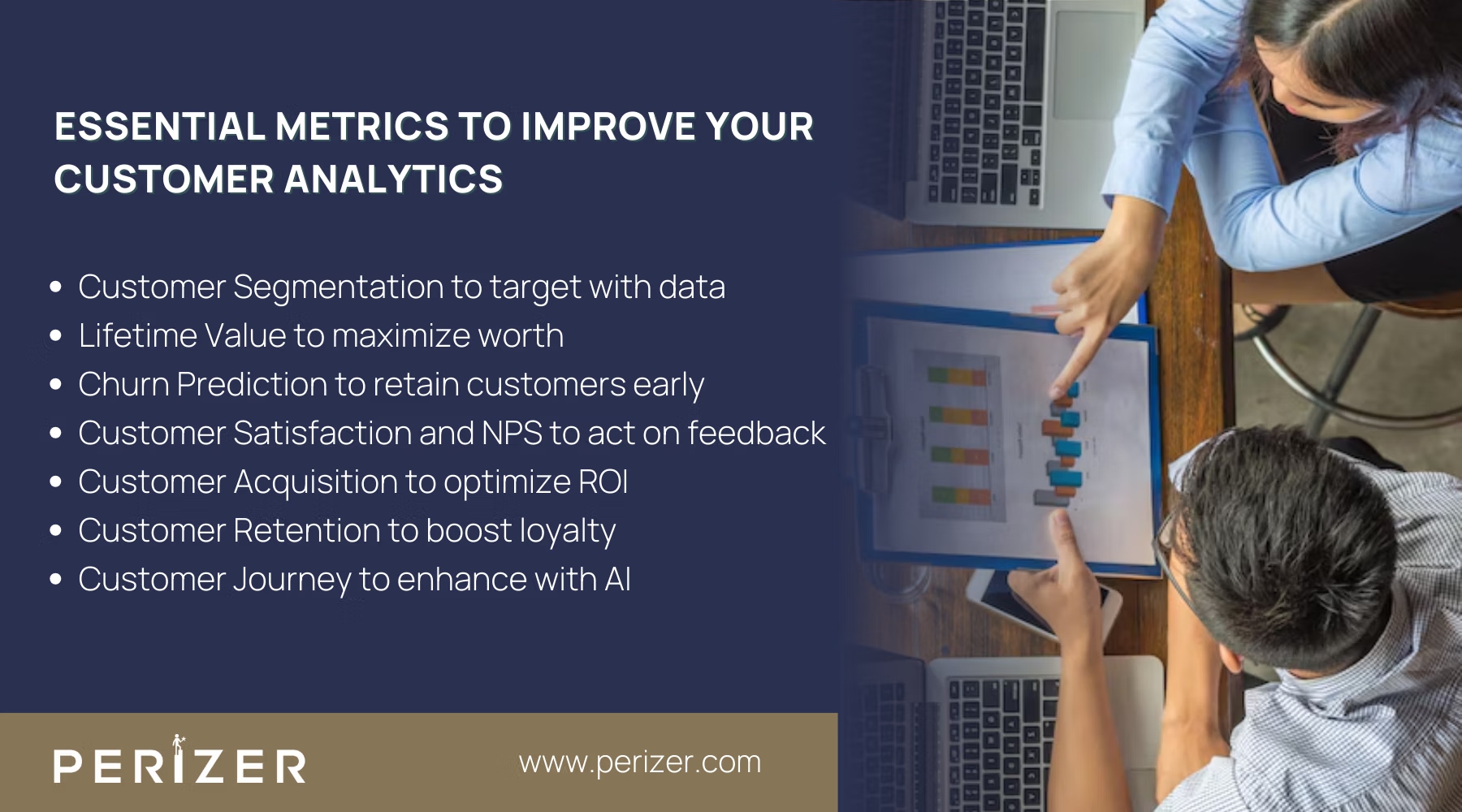Must-Know Metrics to Improve Your Customer Analytics
Unlock the power of customer analytics to stay ahead, build stronger customer relationships, and grow your business. Discover the metrics that make a difference!

If you’re still relying on basic metrics, you’re missing out—and your competitors might be getting ahead. The truth is, just looking at the surface data isn’t enough anymore. To understand your customers, you need to go deeper with advanced customer analytics. Think about it - what if you could know exactly when a customer is about to leave or when they’re ready to buy more? This isn’t just about keeping up; it’s about being the one who sets the pace.
In this guide, we’ll explore seven key metrics that will change the way you look at your customer data and help you make smarter decisions to keep your business growing.
Essential Metrics to Improve Your Customer Analytics

1. Customer Segmentation: Fine-Tuning Your Marketing
It’s easy to segment customers based on age, gender, or location. However, these generalized categories barely scratch the surface. To truly benefit from customer segmentation, you need to move past the basics and focus on behavioral, psychographic, and transactional data.
Start by gathering detailed data on customer interactions - this includes every click, purchase, and even the time spent on each page of your website. Advanced segmentation involves clustering algorithms that identify hidden patterns within your data.
For instance, using k-means clustering, you can create micro-segments based on purchasing habits, preferred product categories, and even the time of day they’re most likely to make a purchase. Once you’ve identified these segments, create your marketing strategies to address the specific needs and preferences of each group.
2. Lifetime Value: Maximizing Customer Worth
Lifetime Value (LTV) is often seen as a straightforward calculation, but it’s much more complex when done right. Traditional LTV calculations focus on average revenue per user (ARPU) and the expected lifespan of a customer. However, this static approach overlooks the dynamic nature of customer relationships.
To predict and maximize LTV, you should incorporate factors like customer retention rates, acquisition costs, and even the likelihood of a customer becoming a brand advocate. Begin by developing predictive models using machine learning algorithms. These models should factor in customer behavior trends, such as frequency of purchases and average order value.
Time-series analysis can help you predict future behavior based on historical data, giving you a clearer picture of a customer’s potential lifetime value.
Increasing LTV isn’t just about getting customers to spend more; it’s about ensuring they stay with you for the long haul. Implement personalized upselling and cross-selling strategies that relate to individual customers.
For instance, if a customer frequently buys a particular type of product, recommend related items or bundle offers created specifically for them. The key is to make these recommendations feel like natural extensions of their purchasing journey, rather than obvious sales tactics.
3. Churn Prediction: Retaining At-Risk Customers
Churn prediction is significant, but many businesses approach it too simplistically. Sure, you might monitor common indicators like a drop in purchase frequency or decreased engagement, but these signs often show up when it’s already too late. The key is to predict churn before it happens, allowing you to take proactive measures.
To get ahead of churn, focus on advanced indicators such as engagement scores, product usage patterns, and even sentiment analysis derived from customer interactions. Building a powerful predictive model starts with identifying the variables that most accurately signal a potential churn.
Machine learning models like logistic regression or random forests help you weigh multiple factors, providing a comprehensive view of churn risk. Once you identify at-risk customers, act quickly—reach out with personalized offers before they disengage. Timing is crucial, and ongoing A/B testing will refine your retention strategies for maximum effectiveness.
4. Customer Satisfaction & NPS: From Feedback to Action
Many businesses collect customer satisfaction scores and Net Promoter Scores (NPS), but few know how to use these metrics to drive real change. The scores alone don’t tell you much; it’s the underlying reasons behind them that matter.
Begin by analyzing the qualitative feedback associated with these scores. Sentiment analysis tools can help you get through open-ended responses, identifying common themes and areas of dissatisfaction. Advanced text mining techniques allow you to go beyond surface-level insights, uncovering deeper issues that may not be immediately apparent.
Once you’ve gathered this data, the challenge is converting it into actionable strategies. For instance, if multiple customers express frustration with a specific aspect of your product, prefer that area for improvement in your development roadmap.
To take it a step further, correlate NPS and satisfaction scores with long-term business metrics like LTV and churn. This will help you understand not just how satisfied your customers are, but how that satisfaction impacts their overall value to your business.
5. Customer Acquisition: Optimizing Spend, Boosting ROI
Customer Acquisition Cost (CAC) is often treated as a static number, but it’s a dynamic metric that should be continuously optimized. While calculating CAC is straightforward, the real challenge comes in balancing it against the value each customer brings.
To optimize CAC, start by mapping out your entire acquisition funnel. Identify the touchpoints that contribute the most to acquisition costs, whether it’s paid ads, content marketing, or referral programs. From there, you can employ advanced attribution models to understand which channels are delivering the best return on investment (ROI). Data-driven attribution models, like multi-touch attribution, offer a more accurate picture of how different channels contribute to a customer’s decision to purchase.
Lowering CAC isn’t just about cutting costs - it’s about optimizing spend to get the highest possible ROI. Experiment with lookalike audiences in your paid campaigns to target high-value customers more efficiently. Additionally, use predictive analytics to forecast CAC trends, allowing you to make informed decisions about where to allocate your marketing budget.
6. Customer Retention: Improving Loyalty
Customer retention is often seen as the domain of loyalty programs, but there’s much more to it than just points and rewards. True retention goes beyond surface-level tactics and focuses on delivering consistent value at every touchpoint.
To accurately measure retention, you need to look beyond simple percentages. Cohort analysis is an advanced method that allows you to track the behavior of specific customer groups over time. By examining how different cohorts interact with your brand, you can identify patterns and create your retention strategies accordingly.
Improving retention requires a personalized approach. Use data to understand what keeps your customers coming back, and then use that information to create the best retention strategies. For example, if data shows that a particular segment of customers responds well to email updates, focus on creating highly targeted email campaigns that provide value, such as exclusive content or early access to new products.
7. Customer Journey: Optimizing Touchpoints
The customer journey is no longer a linear path; it’s a complex web of interactions across multiple channels. To optimize your customer experience, you need to move beyond basic journey maps and go into multi-channel, dynamic journey analytics.
Start by mapping out every touchpoint in your customer’s journey, from initial awareness to post-purchase interactions. Advanced journey mapping involves analyzing data from various sources, including digital and offline channels, to create a comprehensive view of the customer experience.
Identifying bottlenecks is the next step. Use data from these touchpoints to pinpoint areas where customers are experiencing friction. For instance, if you notice a drop-off in conversions at a specific stage, investigate the factors contributing to this decline, such as slow loading times or unclear calls to action.
To optimize the customer journey, take a proactive approach. Keep an eye on real-time data and adjust your strategies as needed. For instance, if you notice customers frequently abandoning their carts at checkout, try adding one-click checkout or offering a limited-time discount to boost conversions.
Also, consider using AI insights to personalize each customer’s experience. By analyzing past behavior, AI can help predict what your customers might do next, allowing you to create the journey to meet their unique needs.
Conclusion
Don’t just manage your data—master it. Achieving real business growth isn’t just about tracking numbers; it’s about turning those numbers into meaningful actions. By fully understanding these seven advanced customer analytics metrics, you’re not just staying competitive - you’re taking the lead. Whether you’re refining customer segmentation, predicting lifetime value, or preventing churn before it happens, each strategy helps you make smarter, informed decisions.
Remember, success is in the details - getting to know your customers better, anticipating their needs, and adjusting your strategies to meet them. This approach will transform your analytics from basic management to true mastery, guiding your business toward lasting growth and profitability.
FOCUSED, FAST, GOVERNMENT READY
Stay Tuned With Our Latest Insights

Staff Augmentation
Learn how to select the perfect IT outsourcing partner to promote your team’s capabilities, improve productivity, and drRead more...

Staff Augmentation
Find the perfect staff augmentation partner by aligning your goals, evaluating expertise, managing costs, and ensuring aRead more...

Cyber Security
We focus on understanding the needs, behaviors, and expectations of your users through extensive user research. This infRead more...